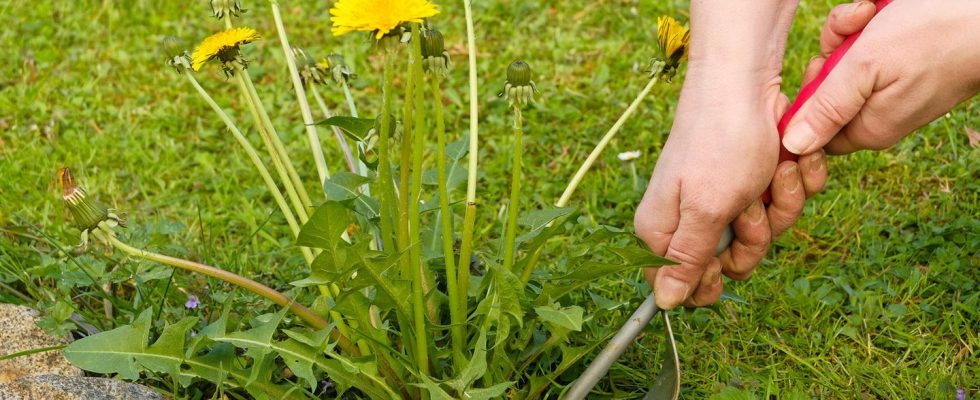Medicinal plant and weed
(Gardening) friend or enemy? Here’s what you should know before removing dandelions
As annoying as they may be, dandelions are an important source of nectar and pollen for many insects
© Leonsbox/Getty Images
As nice as it is to watch a dandelion as its seeds take off into the air with every gust of wind – for many garden owners, the dandelion is an annoying companion: it spreads out in beds, paving joints or on the lawn and bites itself there downright solid. However, since it is an important food source for insects, you should remove the plant carefully. We’ll tell you what that means.
Due to its low demands on the environment, dandelions grow almost everywhere – to the delight of many insects, but also to the chagrin of many hobby gardeners. The dandelion is a perennial (medicinal) plant that always returns unless it is removed from the ground along with its deep-seated taproot. The question arises as to which is better: remove the dandelions or simply leave them there for the love of nature? The star explains to you what advantages the alleged “weed” brings with it and gives tips on how you can remove the plant from beds, paving joints or lawns in the long term.
That’s why dandelion is an important source of food
The pollen and nectar from dandelions help wild and honey bees in particular to raise their offspring. However, the dandelion not only serves as a food source for insects, but also for birds: the goldfinch (also called goldfinch) primarily targets the seeds of the plant. In addition, the leaves of the dandelion are even recommended for humans – for example in salads or as pesto. “The flowers can also be used: for example, you can boil them down and make dandelion syrup,” reveals Volker Weiß from the Nature Conservation Association of Germany. V. (NABU for short). It can be used as a spread on bread or to sweeten hot drinks such as tea.
If you still want to remove the plant, a tip is to wait until the dandelion has faded and then cut off the flowers. This means that dandelions cannot develop and scatter their seeds in the garden.
Removing dandelions: the best tips
The not always welcome garden plant blooms from March to June – and celebrates a comeback in late summer. If you want to remove dandelions from beds, joints or lawns in the long term, you can use the following tips:
- The taproot of the dandelion sits deep (up to one meter) in the soil. As long as it persists, the plant will keep coming back. If you want to prevent this, you have to pull the dandelion and its roots completely out of the ground. One can help with this Weed cutter.
- Once the dandelion has made itself comfortable between paving stones, it can no longer be removed with your bare hands. It’s best to use one manual or electrically operated joint scraperto banish the plants from the cracks as best as possible.
- A proven home remedy that is supposed to help remove dandelions: hot water. Bring this to the boil first before pouring it onto the desired areas. However, keep in mind that the water can harm other plants.
- There are also special ones weed killer for lawns that are overgrown with dandelions. Accordingly, you should not use the product on your (flower) beds as it would combat other ornamental or vegetable plants.
- Rodents literally love to eat dandelions. If you have a guinea pig or rabbit (or can borrow a pet from a friend), just take it with you into the garden.
Another important note: There is a persistent myth that the mixture of vinegar and salt is intended to combat unwanted plants. However, this not only endangers the soil, but also the surrounding plants. For this reason, its use is strongly discouraged.
How to prevent dandelions
If you want to prevent the dandelions from spreading in all directions in your garden, you should always keep an eye on the flowers: If they are still juicy and yellow, they serve as a food source for insects – but if they start to wilt, urgent action is required: Up Green spaces are the most effective way to fire up the lawn mower and cut down the plants before they turn into a dandelion. In your (flower) beds, however, you can cover the flowers with one secateurs split off. You can always take care of the roots later (as described above).
Another way to prevent dandelions is literally buried in the ground: the plant prefers nitrogen-rich soil. Accordingly, avoid fertilizing with nitrogen – especially in areas that are particularly susceptible to dandelions. The same applies to scarifying, as opening the turf creates “free” spaces in the lawn for flying seeds.
Sources: Utopia, Plantura, My beautiful garden, NABU
You might also be interested in:
This article contains so-called affiliate links. Further information are available here.


